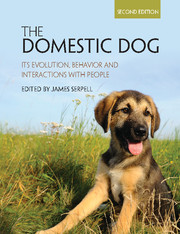Book contents
- Frontmatter
- Dedication
- Contents
- List of contributors
- 1 Introduction
- PART I ORIGINS AND EVOLUTION
- 2 Origins of the dog: The archaeological evidence
- 3 Origins of the dog: Genetic insights into dog domestication
- 4 Evolution of working dogs
- PART II BEHAVIOR, COGNITION AND TRAINING
- PART III DOG-HUMAN INTERACTIONS
- PART IV LIFE ON THE MARGINS
- Index
- Plate section
- References
3 - Origins of the dog: Genetic insights into dog domestication
from PART I - ORIGINS AND EVOLUTION
Published online by Cambridge University Press: 30 December 2016
- Frontmatter
- Dedication
- Contents
- List of contributors
- 1 Introduction
- PART I ORIGINS AND EVOLUTION
- 2 Origins of the dog: The archaeological evidence
- 3 Origins of the dog: Genetic insights into dog domestication
- 4 Evolution of working dogs
- PART II BEHAVIOR, COGNITION AND TRAINING
- PART III DOG-HUMAN INTERACTIONS
- PART IV LIFE ON THE MARGINS
- Index
- Plate section
- References
Summary
Introduction
Dogs are the oldest domesticated animal and today are second only to cats as the most popular pet in western societies (Boyko, 2011; Leonard et al., 2006; Wayne and vonHoldt, 2012). The dog has taken on many significant roles in human society, ranging from companion, sentry, and hunting partner to its more recent function as a model for understanding human disease. By exploring the genetic and evolutionary history of our canine companions, we can better understand not only the natural history of dogs but also our own evolutionary history.
Inquiries into the dog's natural history are now enlightened by molecular and genetic data to an overwhelmingly greater degree then they were 20 years ago when the first edition of this book was published. This trend towards increasing molecular inference will certainly continue, though morphology and archaeology will remain vitally important in completing our understanding of the cultural context of the changes wrought by domestication.
The wolf, ancestor of the dog
The dog and its ancestor, the wolf (Canis lupus), belong to the family Canidae. The 34 living species of canids are grouped into four clades: a red fox-like clade, a South American clade, a wolf-like clade, and a clade comprising only the gray and island fox (Urocyon cinereoargenteus and U. littoralis, respectively) (Lindblad-Toh et al., 2005; Perini et al., 2009) (Figure 3.1). Canids are found in all terrestrial habitats and, with the human-assisted introduction of dogs and foxes to Australia and New Zealand, Antarctica is now the only continent without a resident population. Currently, seven species belong to the dog-like genus Canis (Figure 3.2), which arose nearly six million years ago (mya) in North America and, along with a number of other carnivore species, expanded into Eurasia (4 mya) via the Beringian land bridge, and subsequently into Africa (3 mya) (Wang & Tedford, 2008). The archaeological record indicates that the modern-day gray wolf (Canis lupus lupus) evolved in Eurasia around 3–4 mya, re-invading North America about 500 000 years ago (Wang & Tedford, 2008). Supremely adaptable, the wolf inhabits nearly every habitat and environmental condition (Mech & Boitani, 2003). Wolves vary greatly in size depending on their environmental distribution, from the gracile 13 kg wolves of the Middle Eastern deserts to the large robust individuals (over 78 kg) of the Arctic tundra.
- Type
- Chapter
- Information
- The Domestic DogIts Evolution, Behavior and Interactions with People, pp. 22 - 41Publisher: Cambridge University PressPrint publication year: 2016
References
- 8
- Cited by



